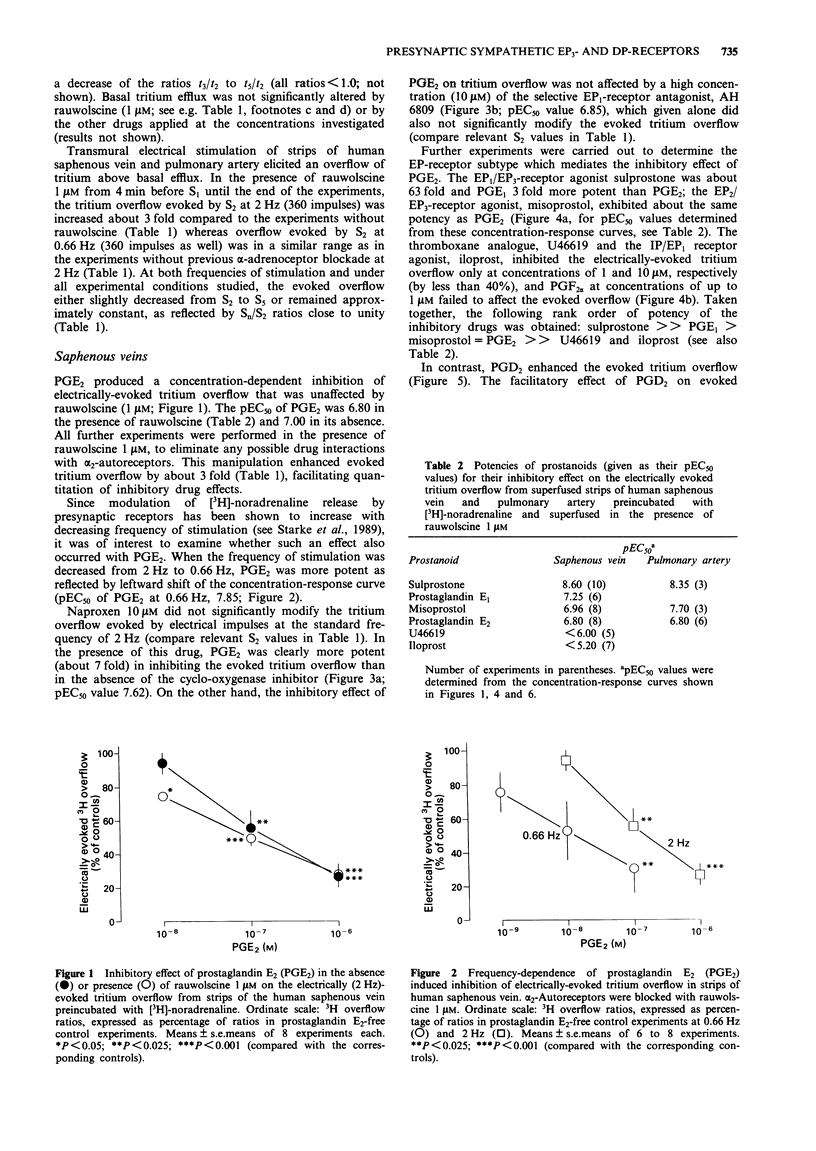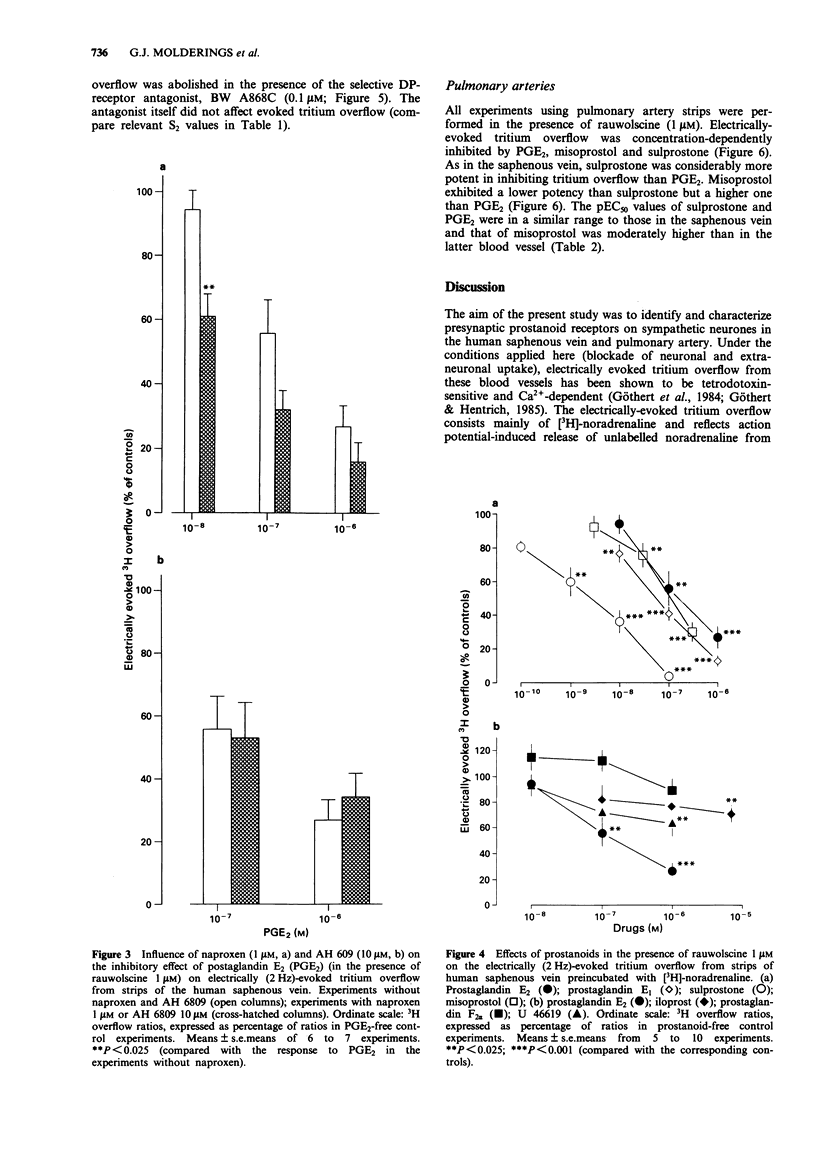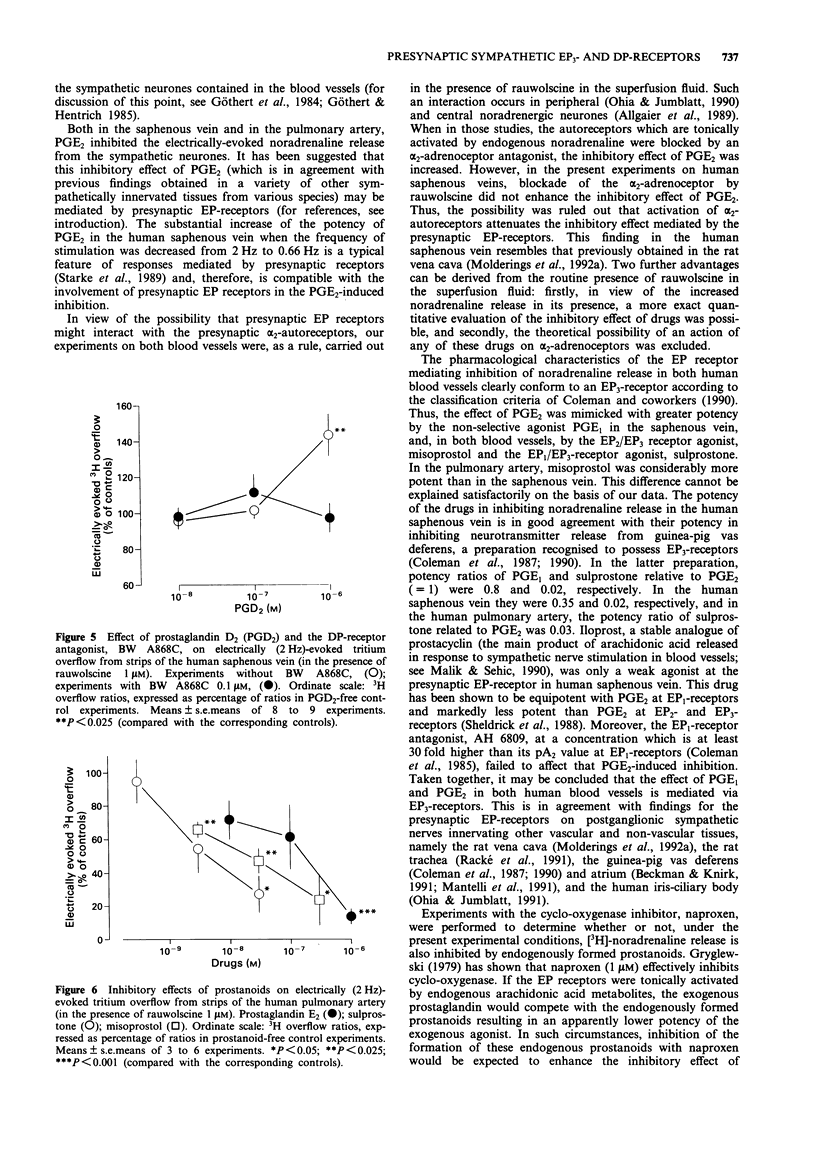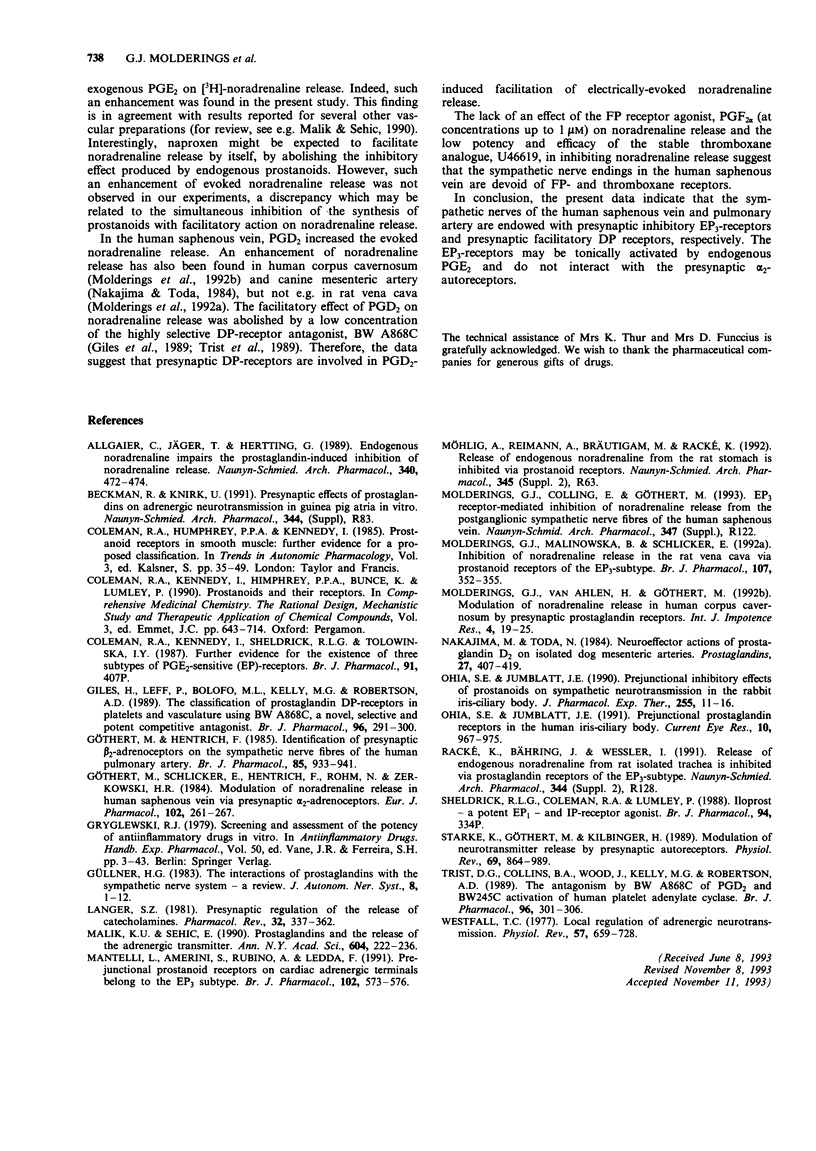Abstract
1. Spirally cut strips of the human saphenous vein and pulmonary artery were used to determine the pharmacological properties of the presynaptic prostanoid receptors involved in the modulation of sympathetic [3H]-noradrenaline release. Strips preincubated with [3H]-noradenaline were superfused with physiological salt solution containing inhibitors of uptake1 and uptake2 and rauwolscine to eliminate involvement of presynaptic alpha 2-adrenoceptors. Tritium overflow was evoked by transmural electrical stimulation (standard frequency: 2 Hz). 2. In the saphenous vein, prostaglandin E2 (PGE2) inhibited the electrically-evoked tritium overflow; at the highest concentration investigated, tritium overflow was inhibited by more than 75% and the pEC50 value was 7.00. These effects were mimicked by prostaglandin E1, the EP1/EP3 receptor agonist, sulprostone and the EP2/EP3 receptor agonist, misoprostol with the rank order (pEC50): sulprostone (8.60) > PGE1 (7.25) > misoprostol (6.96). This rank order of potency suggests that the inhibitory effect of the drugs is mediated by presynaptic EP3-receptors. In contrast, PGF2 alpha did not inhibit evoked tritium overflow; the IP/EP1 receptor agonist iloprost and the stable thromboxane A2 analogue U 46619 (9, 11-dideoxy-11 alpha,9 alpha-epoxy-methanoprostaglandin F2 alpha) produced inhibition only at concentrations above 1 microM. 3. The EP1-receptor antagonist, AH 6809 (6-isopropoxy-9-oxoxanthene-2-carboxylic acid) had no effect on the evoked tritium overflow nor did it modify the inhibitory effect of PGE2, further excluding involvement of inhibitory presynaptic EP1-receptors.(ABSTRACT TRUNCATED AT 250 WORDS)
Full text
PDF





Selected References
These references are in PubMed. This may not be the complete list of references from this article.
- Allgaier C., Jäger T., Hertting G. Endogenous noradrenaline impairs the prostaglandin-induced inhibition of noradrenaline release. Naunyn Schmiedebergs Arch Pharmacol. 1989 Oct;340(4):472–474. doi: 10.1007/BF00167051. [DOI] [PubMed] [Google Scholar]
- Giles H., Leff P., Bolofo M. L., Kelly M. G., Robertson A. D. The classification of prostaglandin DP-receptors in platelets and vasculature using BW A868C, a novel, selective and potent competitive antagonist. Br J Pharmacol. 1989 Feb;96(2):291–300. doi: 10.1111/j.1476-5381.1989.tb11816.x. [DOI] [PMC free article] [PubMed] [Google Scholar]
- Göthert M., Hentrich F. Identification of presynaptic beta 2-adrenoceptors on the sympathetic nerve fibres of the human pulmonary artery. Br J Pharmacol. 1985 Aug;85(4):933–941. doi: 10.1111/j.1476-5381.1985.tb11094.x. [DOI] [PMC free article] [PubMed] [Google Scholar]
- Göthert M., Schlicker E., Hentrich F., Rohm N., Zerkowski H. R. Modulation of noradrenaline release in human saphenous vein via presynaptic alpha 2-adrenoceptors. Eur J Pharmacol. 1984 Jul 13;102(2):261–267. doi: 10.1016/0014-2999(84)90257-7. [DOI] [PubMed] [Google Scholar]
- Langer S. Z. Presynaptic regulation of the release of catecholamines. Pharmacol Rev. 1980 Dec;32(4):337–362. [PubMed] [Google Scholar]
- Malik K. U., Sehic E. Prostaglandins and the release of the adrenergic transmitter. Ann N Y Acad Sci. 1990;604:222–236. doi: 10.1111/j.1749-6632.1990.tb31996.x. [DOI] [PubMed] [Google Scholar]
- Mantelli L., Amerini S., Rubino A., Ledda F. Prejunctional prostanoid receptors on cardiac adrenergic terminals belong to the EP3 subtype. Br J Pharmacol. 1991 Mar;102(3):573–576. doi: 10.1111/j.1476-5381.1991.tb12214.x. [DOI] [PMC free article] [PubMed] [Google Scholar]
- Molderings G., Malinowska B., Schlicker E. Inhibition of noradrenaline release in the rat vena cava via prostanoid receptors of the EP3-subtype. Br J Pharmacol. 1992 Oct;107(2):352–355. doi: 10.1111/j.1476-5381.1992.tb12750.x. [DOI] [PMC free article] [PubMed] [Google Scholar]
- Nakajima M., Toda N. Neuroeffector actions of prostaglandin D2 on isolated dog mesenteric arteries. Prostaglandins. 1984 Mar;27(3):407–419. doi: 10.1016/0090-6980(84)90199-0. [DOI] [PubMed] [Google Scholar]
- Ohia S. E., Jumblatt J. E. Prejunctional inhibitory effects of prostanoids on sympathetic neurotransmission in the rabbit iris-ciliary body. J Pharmacol Exp Ther. 1990 Oct;255(1):11–16. [PubMed] [Google Scholar]
- Ohia S. E., Jumblatt J. E. Prejunctional prostaglandin receptors in the human iris-ciliary body. Curr Eye Res. 1991 Oct;10(10):967–975. doi: 10.3109/02713689109020333. [DOI] [PubMed] [Google Scholar]
- Starke K., Göthert M., Kilbinger H. Modulation of neurotransmitter release by presynaptic autoreceptors. Physiol Rev. 1989 Jul;69(3):864–989. doi: 10.1152/physrev.1989.69.3.864. [DOI] [PubMed] [Google Scholar]
- Trist D. G., Collins B. A., Wood J., Kelly M. G., Robertson A. D. The antagonism by BW A868C of PGD2 and BW245C activation of human platelet adenylate cyclase. Br J Pharmacol. 1989 Feb;96(2):301–306. doi: 10.1111/j.1476-5381.1989.tb11817.x. [DOI] [PMC free article] [PubMed] [Google Scholar]
- Westfall T. C. Local regulation of adrenergic neurotransmission. Physiol Rev. 1977 Oct;57(4):659–728. doi: 10.1152/physrev.1977.57.4.659. [DOI] [PubMed] [Google Scholar]


